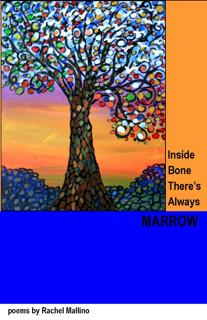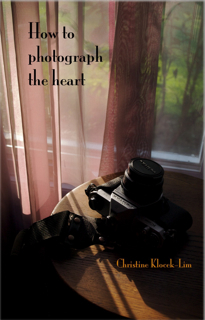11.13.09
A review – Inside Bone There’s Always MARROW by Rachel Mallino

For me, a successful poem must tell a story so convincingly that I am transported to within its borders to feel, taste, and experience the events portrayed, as much as I must come to know the characters through the skill of the poet’s pen. Such were my travels into the world of four generations of a matriarchal bloodline created by Rachel Mallino.
The stories reflected in the 27 poems of Inside Bone There’s Always MARROW from Maverick Duck Press, May 2009, could have devolved into a journey of self pity on a road to hell and remained there in lesser hands, but this poet explores a reality of a tormented mother who creates a life of neglect and abuse for her child with absolute clarity as much as she reveals a child who possesses an inner strength of character that states, simply, “I choose to live.” As the child moves through adolescence into adulthood, ultimately to become a mother herself, her journey is filled with tumultuous encounters as she attempts to protect her progeny and her life by encasing her own past in self analysis and restraint.
Mallino explores each moment with a keen eye and brutal honesty, yet she treats each topic and subject with respect while she directly explores the issues that traverse her poetry. She takes us to where it all began: “my body: cell, blood, bone / all fortified in my mother’s / brackish womb” (1-3), and to an ultimate understanding: “when a mother isn’t a mother / at all, but a small vessel unfit to carry / even her own posture” (12-14) in the poem that titles her collection.
In “An Explanation of the Tales We Tell,” she reflects on a child’s attempt to protect her grandmother: “O, to make it all bearable: / the wild pack of dogs that chewed / my grandmother’s face to bits; / the icy stare I learned at seven / for anyone who disclaimed / the animal attack / and called it cancer instead” (1-7), the child’s attempt to comprehend: “… the sound / of the blender grinding like / teeth against bone: teeth / once rooted inside her gums” (20-23), and the child’s fantasies and dreams of a visit from the tooth fairy.
Mallino pulls no punches in “An Open Poem To god,” as she reveals the loss of childhood innocence: “Dear god, there has always been this / marrow inside of bone. Those retarded / cells that drive nonage to adultery …” (1-3), “It all boils down to sex: mother’s / bony knees beneath / motel sheets as I stared off / into the bends / of brush strokes …” (10-14), “The anonymity / of those painters, like my mother’s lovers, / became famous to me.” (15-17). Nor can one mistake the demotion of the deity.
A shift in vision occurs as the narrator reflects on motherhood and her own child at book center: “These are the shapes of her world” (1), “Everything now is either straight or round. / Even her heart, its triangle base and the top / round like buttocks” (4-6), “her legs – the shape of a wishbone” (12), in “How My Daughter Draws.”
In her closing poem, “Here’s How It Must Have Been,” dedicated to Anne Sexton, Mallino weaves a skilled tapestry of all the works that precede it, tying together images that parallel the lives of both poets: ” … I imagine, at birth, Anne wailed / to be still-born, maddened by the length / of her mother’s umbilical cord – the possibilities” (3-5), “… No wonder / she kept going back, back to the institution where / dinner bells rang at the nurses hand …” (9-11), “back to distant conversations beneath / the long silence of lithium, back to the steel headboard – / her mother’s hipbone” (14-16).
Mallino’s poetry is a literary dissection into the frailty of humanity as it cuts to the marrow of human relationships with raw revelations, and lays our skeletal core exposed for all to see as we struggle for Grace. No poetry could be as antithetic to the work I publish and try to write myself, yet I find myself drawn to it with a sense of compassion, and a sense of respect and admiration for the strength of its author. I am left completely drained and in awe of how, in the hands of a master, poetry can be the window into one’s soul.
O.P.W. Fredericks, Editor
Touch: The Journal of Healing
The Lives You Touch Publications
